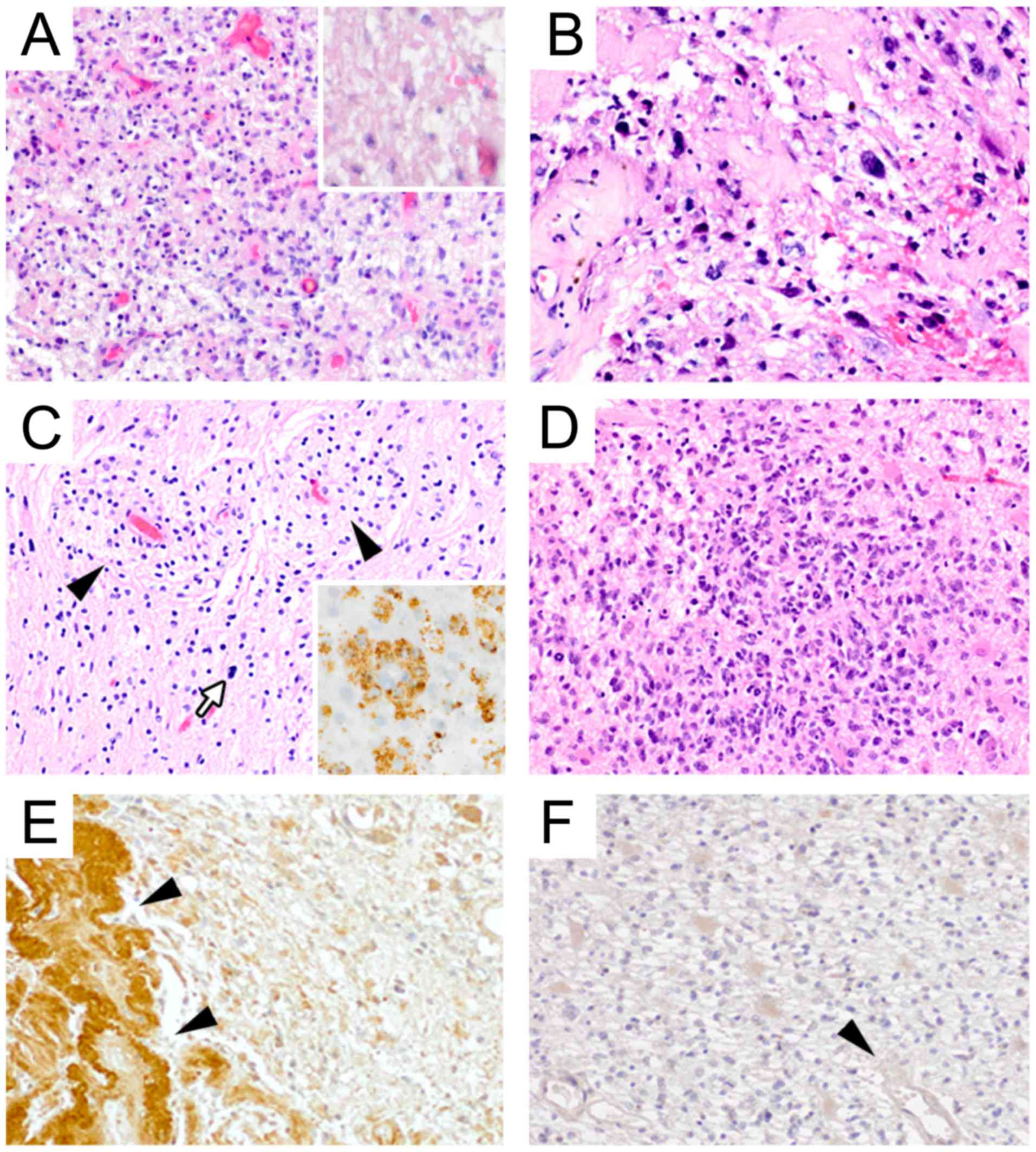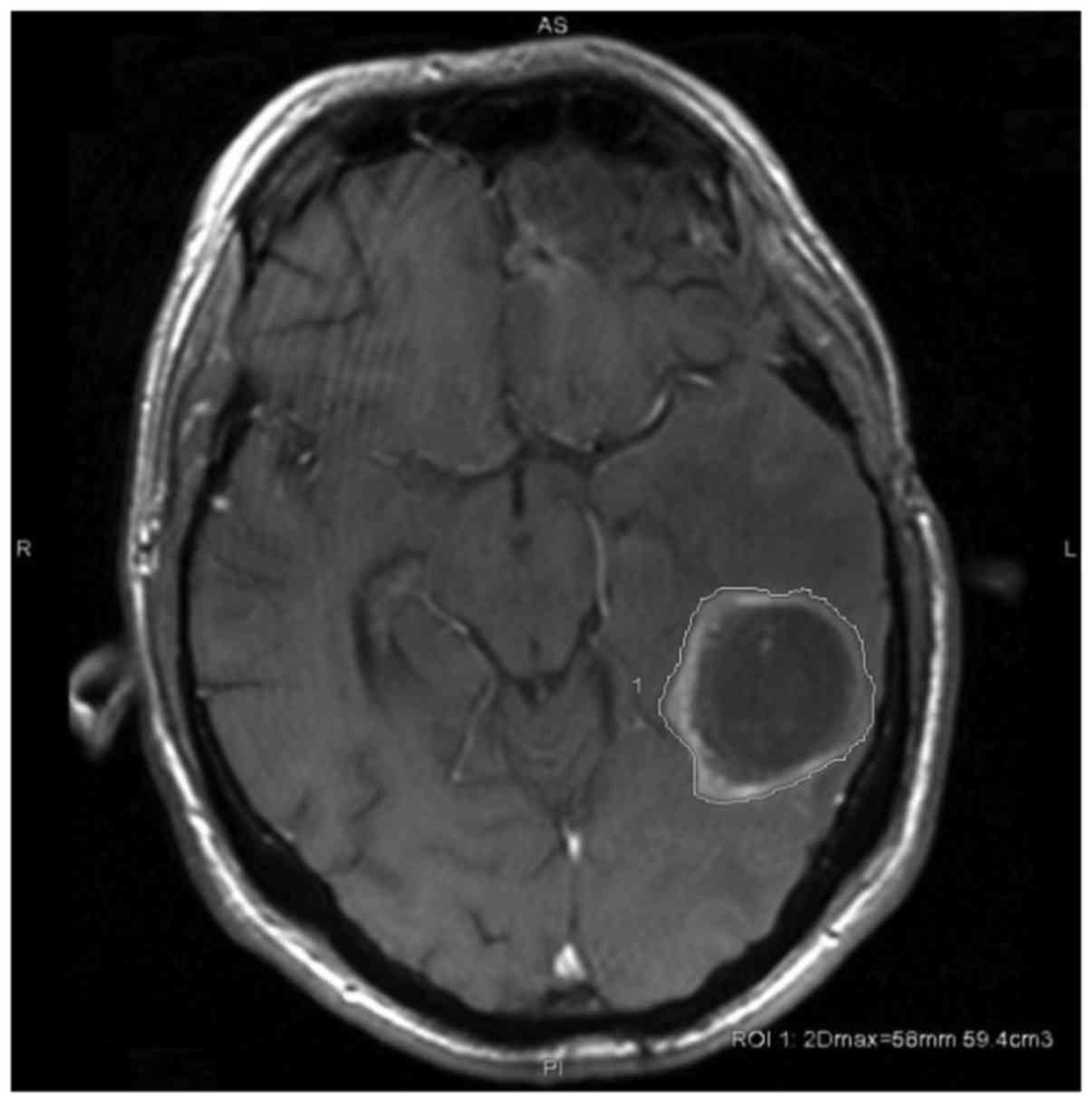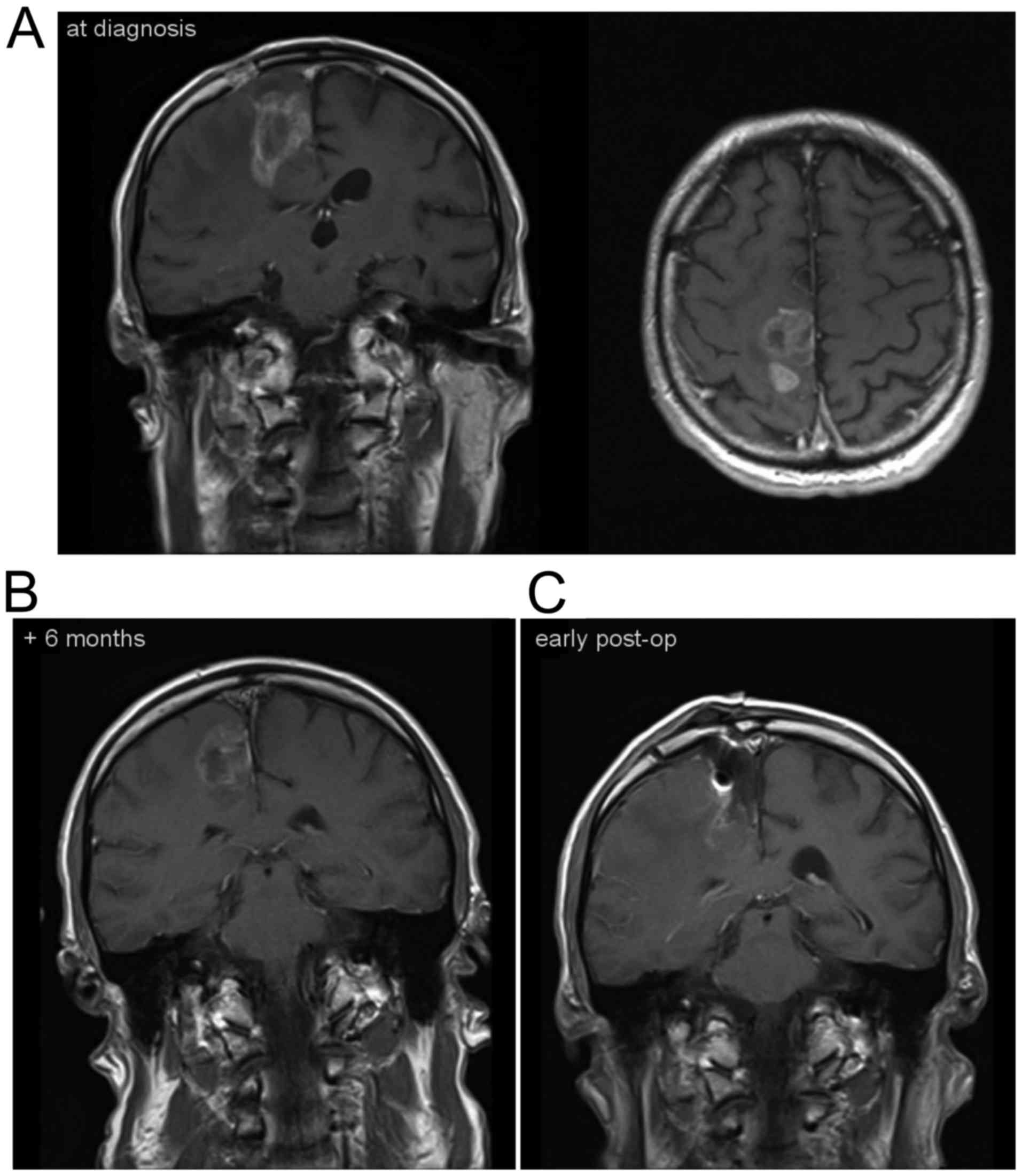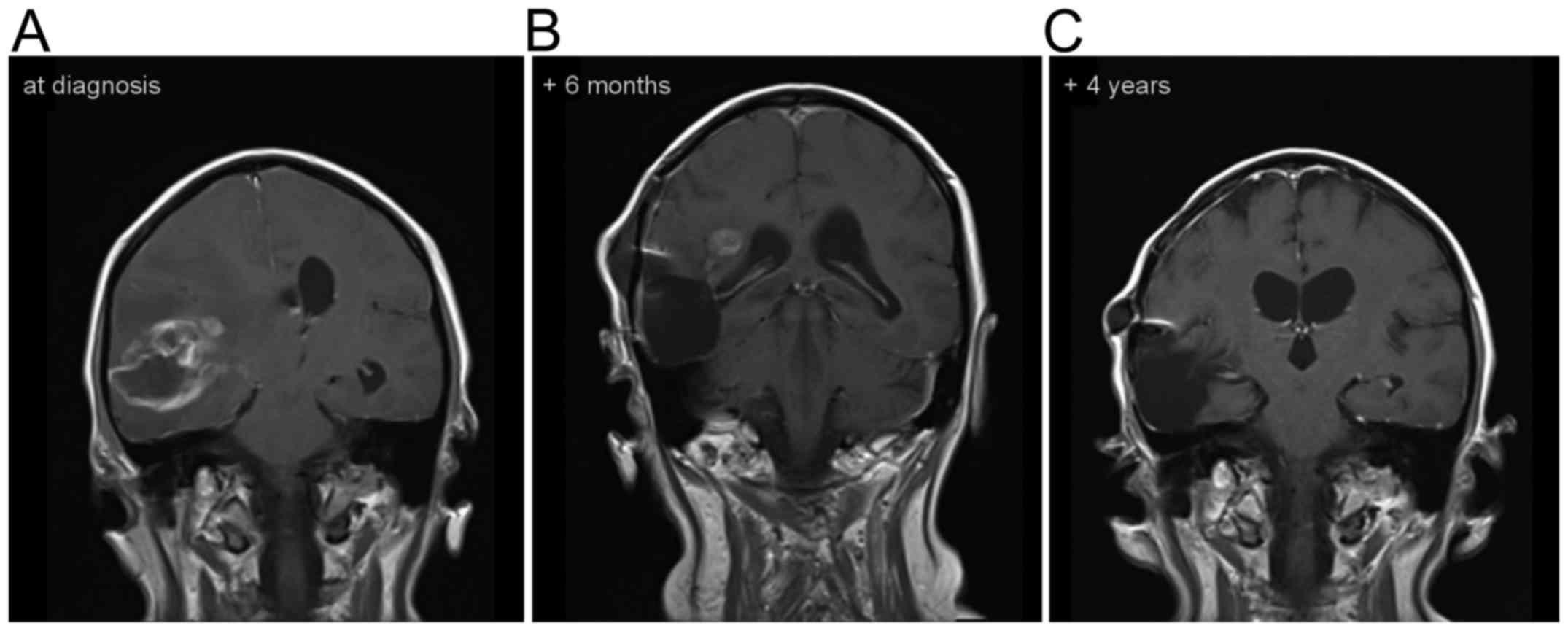|
1
|
Park JK, Hodges T, Arko L, Shen M, Iacono
Dello D, McNabb A, Bailey Olsen N, Kreisl TN, Iwamoto FM, Sul J, et
al: Scale to predict survival after surgery for recurrent
glioblastoma multiforme. J Clin Oncol. 28:3838–3843. 2010.
View Article : Google Scholar : PubMed/NCBI
|
|
2
|
Stupp R, Hegi ME, Mason WP, van den Bent
MJ, Taphoorn MJ, Janzer RC, Ludwin SK, Allgeier A, Fisher B,
Belanger K, et al: Effects of radiotherapy with concomitant and
adjuvant temozolomide versus radiotherapy alone on survival in
glioblastoma in a randomised phase III study: 5-year analysis of
the EORTC-NCIC trial. Lancet Oncol. 10:459–466. 2009. View Article : Google Scholar : PubMed/NCBI
|
|
3
|
Krex D, Klink B, Hartmann C, von Deimling
A, Pietsch T, Simon M, Sabel M, Steinbach JP, Heese O, Reifenberger
G, et al: Long-term survival with glioblastoma multiforme. Brain.
130:2596–2606. 2007. View Article : Google Scholar : PubMed/NCBI
|
|
4
|
Ringel F, Pape H, Sabel M, Krex D, Bock
HC, Misch M, Weyerbrock A, Westermaier T, Senft C, Schucht P, et
al: Clinical benefit from resection of recurrent glioblastomas:
Results of a multicenter study including 503 patients with
recurrent glioblastomas undergoing surgical resection. Neuro Oncol.
18:96–104. 2016. View Article : Google Scholar : PubMed/NCBI
|
|
5
|
Kathagen A, Schulte A, Balcke G, Phillips
HS, Martens T, Matschke J, Günther HS, Soriano R, Modrusan Z,
Sandmann T, et al: Hypoxia and oxygenation induce a metabolic
switch between pentose phosphate pathway and glycolysis in glioma
stem-like cells. Acta Neuropathol. 126:763–780. 2013. View Article : Google Scholar : PubMed/NCBI
|
|
6
|
Seidel S, Garvalov BK, Wirta V, von
Stechow L, Schänzer A, Meletis K, Wolter M, Sommerlad D, Henze AT,
Nistér M, et al: A hypoxic niche regulates glioblastoma stem cells
through hypoxia inducible factor 2 alpha. Brain. 133:983–995. 2010.
View Article : Google Scholar : PubMed/NCBI
|
|
7
|
Zhou Y, Zhou Y, Shingu T, Feng L, Chen Z,
Ogasawara M, Keating MJ, Kondo S and Huang P: Metabolic alterations
in highly tumorigenic glioblastoma cells: Preference for hypoxia
and high dependency on glycolysis. J Biol Chem. 286:32843–32853.
2011. View Article : Google Scholar : PubMed/NCBI
|
|
8
|
Bar EE, Lin A, Mahairaki V, Matsui W and
Eberhart CG: Hypoxia increases the expression of stem-cell markers
and promotes clonogenicity in glioblastoma neurospheres. Am J
Pathol. 177:1491–1502. 2010. View Article : Google Scholar : PubMed/NCBI
|
|
9
|
Eckerich C, Zapf S, Fillbrandt R, Loges S,
Westphal M and Lamszus K: Hypoxia can induce c-Met expression in
glioma cells and enhance SF/HGF-induced cell migration. Int J
Cancer. 121:276–283. 2007. View Article : Google Scholar : PubMed/NCBI
|
|
10
|
Trejo-Solis C, Jimenez-Farfan D,
Rodriguez-Enriquez S, Fernandez-Valverde F, Cruz-Salgado A,
Ruiz-Azuara L and Sotelo J: Copper compound induces autophagy and
apoptosis of glioma cells by reactive oxygen species and JNK
activation. BMC Cancer. 12:1562012. View Article : Google Scholar : PubMed/NCBI
|
|
11
|
Mendichovszky I and Jackson A: Imaging
hypoxia in gliomas. Br J Radiol. 84:S145–S158. 2011. View Article : Google Scholar : PubMed/NCBI
|
|
12
|
Kadayakkara DK, Janjic JM, Pusateri LK,
Young WB and Ahrens ET: In vivo observation of intracellular
oximetry in perfluorocarbon-labeled glioma cells and
chemotherapeutic response in the CNS using fluorine-19 MRI. Magn
Reson Med. 64:1252–1259. 2010. View Article : Google Scholar : PubMed/NCBI
|
|
13
|
Olin MR, Andersen BM, Litterman AJ, Grogan
PT, Sarver AL, Robertson PT, Liang X, Chen W, Parney IF, Hunt MA,
et al: Oxygen is a master regulator of the immunogenicity of
primary human glioma cells. Cancer Res. 71:6583–6589. 2011.
View Article : Google Scholar : PubMed/NCBI
|
|
14
|
Cannizzaro A, Falzacappa Verga CV,
Martinelli M, Misiti S, Brunetti E and Bucci B: O(2/3) exposure
inhibits cell progression affecting cyclin B1/cdk1 activity in
SK-N-SH while induces apoptosis in SK-N-DZ neuroblastoma cells. J
Cell Physiol. 213:115–125. 2007. View Article : Google Scholar : PubMed/NCBI
|
|
15
|
Bocci VA: Scientific and medical aspects
of ozone therapy. State of the art. Arch Med Res. 37:425–435. 2006.
View Article : Google Scholar : PubMed/NCBI
|
|
16
|
Batinjan G, Zore Filipovic I, Vuletic M
and Rupic I: The use of ozone in the prevention of
osteoradionecrosis of the jaw. Saudi Med J. 35:1260–1263.
2014.PubMed/NCBI
|
|
17
|
Brozoski MA, Lemos CA, Da Graca
Naclério-Homem M and Deboni MC: Adjuvant aqueous ozone in the
treatment of bisphosphonate induced necrosis of the jaws: report of
two cases and long-term follow-up. Minerva Stomatol. 63:35–41.
2014.PubMed/NCBI
|
|
18
|
Clavo B, Ceballos D, Gutierrez D, Rovira
G, Suarez G, Lopez L, Pinar B, Cabezon A, Morales V, Oliva E, et
al: Long-term control of refractory hemorrhagic radiation proctitis
with ozone therapy. J Pain Symptom Manage. 46:106–112. 2013.
View Article : Google Scholar : PubMed/NCBI
|
|
19
|
Clavo B, Gutiérrez D, Martín D, Suárez G,
Hernández MA and Robaina F: Intravesical ozone therapy for
progressive radiation-induced hematuria. J Altern Complement Med.
11:539–541. 2005. View Article : Google Scholar : PubMed/NCBI
|
|
20
|
Ripamonti CI, Cislaghi E, Mariani L and
Maniezzo M: Efficacy and safety of medical ozone (O(3)) delivered
in oil suspension applications for the treatment of osteonecrosis
of the jaw in patients with bone metastases treated with
bisphosphonates: Preliminary results of a phase I–II study. Oral
Oncol. 47:185–190. 2011. View Article : Google Scholar : PubMed/NCBI
|
|
21
|
Ripamonti CI, Maniezzo M, Boldini S, Pessi
MA, Mariani L and Cislaghi E: Efficacy and tolerability of medical
ozone gas insufflations in patients with osteonecrosis of the jaw
treated with bisphosphonates-Preliminary data: Medical ozone gas
insufflation in treating ONJ lesions. J Bone Oncol. 1:81–87. 2012.
View Article : Google Scholar : PubMed/NCBI
|
|
22
|
Petrucci MT, Gallucci C, Agrillo A,
Mustazza MC and Foà R: Role of ozone therapy in the treatment of
osteonecrosis of the jaws in multiple myeloma patients.
Haematologica. 92:1289–1290. 2007. View Article : Google Scholar : PubMed/NCBI
|
|
23
|
Herbert RA, Hailey JR, Grumbein S, Chou
BJ, Sills RC, Haseman JK, Goehl T, Miller RA, Roycroft JH and
Boorman GA: Two-year and lifetime toxicity and carcinogenicity
studies of ozone in B6C3F1 mice. Toxicol Pathol. 24:539–548. 1996.
View Article : Google Scholar : PubMed/NCBI
|
|
24
|
Ichinose T and Sagai M: Combined exposure
to NO2, O3 and H2SO4-aerosol and lung tumor formation in rats.
Toxicology. 74:173–184. 1992. View Article : Google Scholar : PubMed/NCBI
|
|
25
|
Donaldson K, Brown GM, Brown DM, Slight J,
Maclaren WM and Davis JM: Leukocyte-mediated epithelial injury in
ozone-exposed rat lung. Res Rep Health Eff Inst. 1–27.
1991.PubMed/NCBI
|
|
26
|
Hoogervorst EM, de Vries A, Beems RB, van
Oostrom CT, Wester PW, Vos JG, Bruins W, Roodbergen M, Cassee FR,
Vijg J, et al: Combined oral benzo[a]pyrene and inhalatory ozone
exposure have no effect on lung tumor development in DNA
repair-deficient Xpa mice. Carcinogenesis. 24:613–619. 2003.
View Article : Google Scholar : PubMed/NCBI
|
|
27
|
Witschi H, Wilson DW and Plopper CG:
Modulation of N-nitrosodiethylamine-induced hamster lung tumors by
ozone. Toxicology. 77:193–202. 1993. View Article : Google Scholar : PubMed/NCBI
|
|
28
|
Last JA, Warren DL, Pecquet-Goad E and
Witschi H: Modification by ozone of lung tumor development in mice.
J Natl Cancer Inst. 78:149–154. 1987. View Article : Google Scholar : PubMed/NCBI
|
|
29
|
Teke K, Ozkan TA, Cebeci OO, Yilmaz H,
Keles ME, Ozkan L, Dillioglugil MO, Yildiz DK and Dillioglugil O:
Preventive effect of intravesical ozone supplementation on
n-methyl-n-nitrosourea-induced non-muscle invasive bladder cancer
in male rats. Exp Anim. 66:191–198. 2017. View Article : Google Scholar : PubMed/NCBI
|
|
30
|
Kiziltan HŞ, Bayir AG, Yucesan G, Eris AH,
İdin K, Karatoprak C, Aydin T, Akcakaya A and Mayadagli A: Medical
ozone and radiotherapy in a peritoneal, Erlich-ascites, tumor-cell
model. Altern Ther Health Med. 21:24–29. 2015.PubMed/NCBI
|
|
31
|
Schulz S, Haussler U, Mandic R, Heverhagen
JT, Neubauer A, Dünne AA, Werner JA, Weihe E and Bette M: Treatment
with ozone/oxygen-pneumoperitoneum results in complete remission of
rabbit squamous cell carcinomas. Int J Cancer. 122:2360–2367. 2008.
View Article : Google Scholar : PubMed/NCBI
|
|
32
|
Rossmann A, Mandic R, Heinis J, Höffken H,
Küssner O, Kinscherf R, Weihe E and Bette M: Intraperitoneal
oxidative stress in rabbits with papillomavirus-associated head and
neck cancer induces tumoricidal immune response that is adoptively
transferable. Clin Cancer Res. 20:4289–4301. 2014. View Article : Google Scholar : PubMed/NCBI
|
|
33
|
Bocci V: Does ozone really ‘cure’ cancer?
Int J Cancer. 123:12222008. View Article : Google Scholar : PubMed/NCBI
|
|
34
|
Luongo M, Brigida AL, Mascolo L and
Gaudino G: Possible therapeutic effects of ozone mixture on hypoxia
in tumor development. Anticancer Res. 37:425–435. 2017. View Article : Google Scholar : PubMed/NCBI
|
|
35
|
Louis DN, Perry A, Reifenberger G, von
Deimling A, Figarella-Branger D, Cavenee WK, Ohgaki H, Wiestler OD,
Kleihues P and Ellison DW: The 2016 World Health Organization
Classification of tumors of the central nervous system: A summary.
Acta Neuropathol. 131:803–820. 2016. View Article : Google Scholar : PubMed/NCBI
|
|
36
|
Delic S, Lottmann N, Jetschke K,
Reifenberger G and Riemenschneider MJ: Identification and
functional validation of CDH11, PCSK6 and SH3GL3 as novel glioma
invasion-associated candidate genes. Neuropathol Appl Neurobiol.
38:201–212. 2012. View Article : Google Scholar : PubMed/NCBI
|
|
37
|
Karnofsky DA: The bases for cancer
chemotherapy. Stanford Med Bull. 6:257–269. 1948.PubMed/NCBI
|
|
38
|
Kewley RJ, Whitelaw ML and Chapman-Smith
A: The mammalian basic helix-loop-helix/PAS family of
transcriptional regulators. Int J Biochem Cell Biol. 36:189–204.
2004. View Article : Google Scholar : PubMed/NCBI
|
|
39
|
Semenza GL: Regulation of mammalian O2
homeostasis by hypoxia-inducible factor 1. Annu Rev Cell Dev Biol.
15:551–578. 1999. View Article : Google Scholar : PubMed/NCBI
|
|
40
|
Wenger RH, Stiehl DP and Camenisch G:
Integration of oxygen signaling at the consensus HRE. Sci STKE.
2005:re122005.PubMed/NCBI
|
|
41
|
Semenza GL: HIF-1 and mechanisms of
hypoxia sensing. Curr Opin Cell Biol. 13:167–171. 2001. View Article : Google Scholar : PubMed/NCBI
|
|
42
|
Lee SJ, Song L, Yang MC, Mao CP, Yang B,
Yang A, Jeang J, Peng S, Wu TC and Hung CF: Local administration of
granulocyte macrophage colony-stimulating factor induces local
accumulation of dendritic cells and antigen-specific CD8+ T cells
and enhances dendritic cell cross-presentation. Vaccine.
33:1549–1555. 2015. View Article : Google Scholar : PubMed/NCBI
|
|
43
|
Kucuksezer UC, Zekiroglu E, Kasapoglu P,
Adin-Cinar S, Aktas-Cetin E and Deniz G: A stimulatory role of
ozone exposure on human natural killer cells. Immunol Invest.
43:1–12. 2014. View Article : Google Scholar : PubMed/NCBI
|
|
44
|
Andreula CF, Simonetti L, De Santis F,
Agati R, Ricci R and Leonardi M: Minimally invasive oxygen-ozone
therapy for lumbar disk herniation. AJNR Am J Neuroradiol.
24:996–1000. 2003.PubMed/NCBI
|
|
45
|
Adeberg S, Bostel T, König L, Welzel T,
Debus J and Combs SE: A comparison of long-term survivors and
short-term survivors with glioblastoma, subventricular zone
involvement: A predictive factor for survival? Radiat Oncol.
9:952014. View Article : Google Scholar : PubMed/NCBI
|













